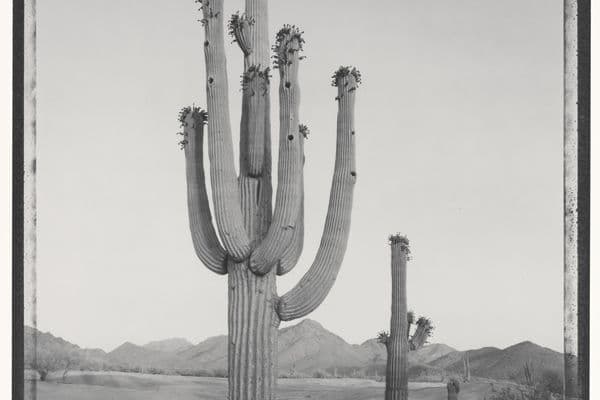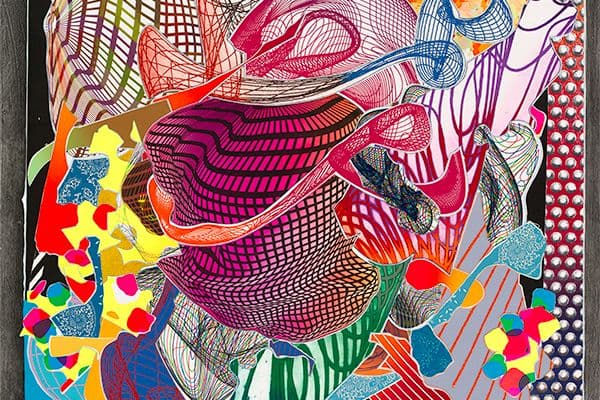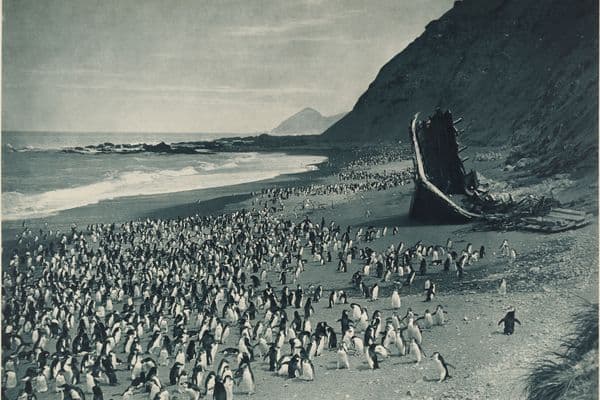Nineteenth-Century Photography
The Formative Decades 1840s–1890s
19 Dec 1987 – 3 Apr 1988

Julia Margaret Cameron, No title ("And Enid sang")., 1874, National Gallery of Australia, Kamberri/Canberra, Purchased 1979.
About
On 7 January 1839, an astonishing invention was announced in Paris. Louis Jacques Mandé Daguerre had developed a process which could permanently record objects simply through the use of light acting on certain chemicals. This seemingly magical invention was photography and it was rapidly to become the world's dominant visual medium.
In the formative decades of photography practitioners vigorously explored the many possibilities the new art/science offered. They applied it to such diverse disciplines as botany, geology, archaeology, architecture and the infant science of anthropology. As well, they used the camera to take portraits, reproduce art works and document expeditions and places. Some also employed the medium for personal creative expression. The most accomplished of the early art photographers brought to their work a sense of picture-making derived from other traditional media such as painting and printmaking and a delight in the special characteristics that photography alone possesses.
This exhibition, drawn from the Australian National Gallery's permanent collection, aims to show some of this diversity. The Gallery's holdings of international nineteenth-century photographs is still relatively small and key works by some important photographers, particularly those from the United States are still to be acquired.
William Henry Fox Talbot
Among the many exceptionally rare and beautiful photographs already in the National Gallery's collection are those by Englishman William Henry Fox Talbot, published in his book The Pencil of Nature. Talbot was one of the main inventors of photography, having formulated his own process sometime before the dramatic public announcement of Daguerre's rival invention. Initially Talbot believed he had been pre-empted in his discovery but it was soon apparent that the two processes were distinctly different, both in technique and appearance. The daguerreotype was a unique direct positive image on a highly reflective copper plate whilst Talbot's 'calotype' was a print on paper produced from a negative.
In 1844 Talbot began to publish the first instalments of his landmark publication The Pencil of Nature. It is the world's first photographically illustrated book which combines original photographs with a lively, thoughtful text to present a remarkably prescient visual and theoretical survey of the potential uses of the medium. Complete copies of this book are extremely scarce and the Gallery is especially fortunate to have one in its collection.
The Pencil of Nature reflects Talbot's belief that his new invention could be both science and art. His choice of glassware, books and a leaf as subjects, for instance, was intended to display photography's most distinctive and unique feature — its ability to delineate, in precise detail, a piece of the world. Coupled with the camera's supposed objectivity it was clearly a recording instrument of immense value to the scientist.
But Talbot, who was both a respected scientist and an amateur artist, also experimented with aesthetic applications of the medium. He believed photography would be an invaluable aid to painters, providing them with an exact transcription of nature which they could refer to and extract details from and, more perceptively, allowed that photography itself could be used for artistic expression.
Talbot clearly sought such expression in his photograph The open door. This carefully constructed scene was consciously modelled on Dutch seventeenth-century genre paintings, both to indicate its artistic aspirations and to allay any criticism of his choice of such a prosaic scene. In his accompanying text Talbot notes that painters, and by extension photographers, are able to find beauty in the everyday. He continues: 'A casual gleam of sunshine, or a shadow thrown across his path, a time-withered oak, or a moss covered stone may awaken a train of thoughts and feelings, and picturesque imaginings'.
Talbot's theories on photography's potential were prophetic. He also proved to be something of an inspiration for the first generation of British photographers.
Like Talbot, men and women with liberal educations, inherited wealth and abundant leisure time, frequently dabbled in the fields of science and art. In the mid-nineteenth century the discipline of science, in particular, was sufficiently 'open' to allow amateurs to make real contributions. As members of the scientific societies and clubs which proliferated in England in this period, these amateurs were among the first to learn of photography, and many found it provided a most satisfying mix of the chemical and aesthetic. Indeed, as one contemporary writer noted, it was initially 'The scientific amusement of the higher classes'.
In the 1850s keen photographers began to form their own special organizations, meeting regularly to swap details of their trials and successes and to hold exhibitions. They also published journals with articles on various technical improvements, hints for better pictures and heated debates on photography's status as an art form.
Women in Early Photography
Women were not excluded from the societies and produced important, if now often generally neglected, photographs. One major early woman photographer whose work has only recently become known to a wider audience is Anna Atkins.
Atkins was an ardent botanist, who used the striking Prussian-blue-coloured cyanotype process invented by family friend Sir John Herschel to create meticulously arranged reproductions of plants. Her major work, British Algae: Cyanotype Impressions, was a privately published and distributed book produced over ten years from 1843. Later projects include the album Cyanotypes of British and Foreign Flowering Plants, from which the Gallery's four works have been taken. This album was given by Atkins to her friend and amateur botanist Anne Dixon, with whom she frequently collaborated on photographic projects. Unlike her earlier work, these cyanotypes break away from strictly scientific concerns to exhibit a greater interest in visually expressive designs.
A circle of aristocratic women photographers formed around Queen Victoria who, along with Prince Albert, was an ardent amateur and collector of photographs. Viscountess Frances Jocelyn was one such lady; she exhibited work at the Royal Photographic Society and used her own and commercial, purchased photographs to create delightful and often witty hand-painted montages in her private albums.
Nineteenth-century photographs were frequently intended for such private collections but, as well, were bound into commercially produced albums and used as illustrations in books. One of Britain's earliest and most ambitious projects in photographic book illustration was the production of original photographs as a visual inventory of entries to the Great Exhibition in London in 1851. The mammoth task of printing the 20 150 negatives required for the Jurors' Reports was undertaken by Nicholaas Henneman, the ex-manager of Talbot's photographic printing company in Reading. Besides providing proof of the value of photography as a documentary medium, many of the photographs, especially those by Hugh Owen, display a fine and sensitive sense of composition.
Early French Photography
Across the English Channel, French photographers were also making significant contributions. In the late 1840s some adopted the salted paper process developed by Talbot, preferring its softer tonal qualities and reproducibility to the more detailed but colder finish of the daguerreotype. One of the main supporters of the paper process was Louis-Désiré Blanquart-Evrard, who was to become the main photographic printer and publisher of the 1850s.
Using his own modified version of the calotype process, Blanquart-Evrard, and his colleague Hippolyte Fockeday, established the Imprimerie Photographique. Before its closure in 1855, this publishing company produced twenty-four albums of photographs containing some of the finest work produced by the period's leading photographers. Blanquart-Evrard was himself an amateur photographer and the exhibition includes one of his now rare early photographs, taken in 1846, of the marketplace at Ypres.
Amongst the artists whose work was published by the Imprimerie Photographique was a small group who travelled to the Middle East on commission from the French Ministry of Education. Félix Teynard, Maxime Du Camp and Auguste Salzmann were instructed to document important monuments and ancient architecture as part of a visual catalogue of such sites. Partly inspired by Napoléon lll's desired political and economic expansion into the region, these 'conquêtes pacifiques', or peaceful conquests, as one contemporary termed them, were armed with that most modern and accurate of recording devices — the camera.
Despite the scientific impulse of the expeditions, the resulting photographs are not prosaic documents, but picturesque interpretations of the physical symbols of ancient cultures. Often permeated by a silent, slightly melancholic air, the photographs are evocative of a bygone age; a nostalgic quality accentuated by the grainy non-specific nature of the salted paper process. As the French critic Francis Wey wrote in 1851 in relation to the photographs of Hippolyte Bayard: 'Light grazes and shadows caress them. The daylight itself seems fantastic and the peculiar sobriety of the effect renders them monumental'.
More suggestive still are the atmospheric images by John B. Greene, who, in 1855, a year before his death, travelled to Egypt to document archaeological sites. At the time his photographs were considered 'macabre', presumably as they obscured rather than revealed detail. Greene's poetic, dreamy vision certainly does appear to have little connection to the straight documentation he was evidently employed to produce.
Such an obviously personal vision is relatively unusual in French photography of the 1850s, where more commonly the talents of leading photographers were harnessed by the government of Napoléon lll. The Emperor appears to have been aware of the propaganda power of the medium and commissioned many of the country's leading photographers to work on various projects intended to increase the prestige of his reign. Charles Négre, for instance, documented the opening of the Imperial Asylum at Vincennes in 1859 in a series of small, finely composed studies of the patients and staff, clearly intended to celebrate the Emperor's benevolence to his people. In another project of similar nationalistic intent Edouard Baldus was selected as one of five prominent photographers to document the country's finest architectural achievements.
Another photographer associated with Napoléon lll was Adolphe Braun, who became the Emperor's court photographer in the 1850s. Braun's large-scale, strikingly arranged photographs of flowers were extremely popular, winning him a gold medal at the Exposition Universelle in Paris in 1855.
Photography and Adventure
Photographs of national achievements were popular on a commercial scale, as locals and travellers were eager for souvenirs to commemorate their visits to various countries. Most eagerly sought by Westerners were photographs of the 'strange' and 'foreign' lands of the Middle East and Asia. The perceived exoticism of the East had long excited the imagination of Westerners and whilst most were aware of the people, their customs and picturesque sites through prints and watercolours (often contained in so-called 'view books'), the veracity of the photograph gave such scenes a new, convincing stamp of authenticity.
Technical improvements in the 1860s, which included shorter exposure times, more easily transportable equipment and the development of the albumen silver process — whose glass plates permitted a greater number of prints to be made — encouraged the rise of the commercial photographer. Many of the new professionals travelled to the Orient in quest of exciting subjects which would guarantee good sales at home. They placed the photographs in albums, made them into postcards and stereographs. Stereographs, in particular, were an enormously popular form of entertainment, consisting of paired photographs which appeared three-dimensional when placed in special viewers. They gave the illusion of real life, if not movement, in the days before films were invented.
A particularly adventurous photographer was Felice Beato who was permitted to accompany the Anglo-French forces in their assault on China in 1860. He managed to please his military patrons, by producing photographs which emphasized the allies' victorious encounters, as well as taking commercial views of the architecture and people of China. These formally composed, picturesque photographs belie the generally violent nature of the Western encounter with the Chinese. His photograph of the tranquil waters of Lake Hy-cheen, for instance, conveniently obscures the fact that the magnificent Imperial Summer Palace on its shores was at that time being looted and burnt by British and French troops.
A personal viewpoint of a very different kind informs the work of landscape photographers in England. Far from the Empire's battlefields in China or India, artists such as Henry White and Victor A. Prout portray the waterways and countryside of England as rural idylls. Their photographs present a peaceful, verdant country, untouched by the realities of industrialization. Prout, like P.H. Emerson after him, photographed from his houseboat, on which he gently cruised the River Thames from London to Oxford around 1862. His delicate panoramic photographs show people in harmony with their environment, ready to submit to the unchanging course of the river.
Narrative and Expression
Other popular subjects amongst British photographers from the 1850s to the 1870s were genre and narrative scenes and portraits. Basing their work on existing styles in painting and printmaking, photographers such as H.P. Robinson and Oscar Gustave Rejlander believed strongly that photography should be considered as equal to other fine art media. Rejlander pioneered the use of combining negatives to create composite photographs, and advocated a controversial aesthetic of print manipulation which he believed would help meld photography and painting. Robinson and Rejlander's fight for photography as art was also waged in their many lectures, articles and books.
Rejlander is also known for his photographs in Charles Darwin's book, The Expression of Emotions in Man and Animals. This classic physiognomic study of emotions is premised on the belief that photography did not lie — thus providing irrefutable scientific proof. Others to use photography in scientific experiments were Etienne Jules Marey and Eadweard Muybridge, whose studies of human and animal locomotion employed several cameras placed at different angles to simultaneously record different views of their subjects.
Perhaps today's best known early British photographer is Julia Margaret Cameron, who used the medium exclusively for personal artistic expression. Cameron had an amateur's zeal and intuitive talent for photography, which she had taught herself in 1863 at the age of forty-eight. The exhibition includes a range of her best known portraits, including the relatively straight but still sensitive and powerful study of her friend, scientist Sir John Herschel, as well as more allegorical images. Like other nineteenth- century photographers, Cameron took pleasure in creating tableaux. She dressed her friends and family in period clothes to help evoke religious figures; and used them as players to enact scenes from poems, such as those from Alfred, Lord Tennyson's Idylls of the Kings.
Another major figure in the formative decades of British photography was P.H. Emerson, whose controversial 'naturalistic' aesthetic opposed the dominant photographic style of the 1880s. He advocated the use of natural, unposed subject matter and unretouched negatives. The main outlet for his photographs was his books, which combine gentle, lyrical images of life in the picturesque rural areas of Norfolk and Suffolk with detailed, rather eclectic texts, generally written by himself. He approached the people of these regions as an anthropologist collecting visual and written data on their distinctive lifestyles. However, this often scientific method is betrayed by the genuine emotional attachment he felt for the region.
It is also indicative of Emerson's apparently contradictory nature that, despite his condemnation of photographers who sought the medium's acceptance as an art form through the imitation of painting and printmaking, his own photographs owe a debt to the work of French artist Jean François Millet. As in Millet's paintings, Emerson's photographs do not depict individuals but characteristic 'types'.
One of Emerson's more radical theories was that photographs should be taken slightly out of focus, as he believed this was how people in fact saw the world. Ironically this proposition was adopted by the Pictorialists at the turn of the century; a group whose ideas concerning photography were opposed to Emerson's.
The Pictorialists believed the only way to have the medium accepted as art was to produce photographs which copied the generalized effects popular in paintings, prints, drawings and watercolours of the period. They rejected the sharp-focus, finely detailed photographs of the mid-nineteenth century for soft-focus impressionistic effects and largely ignored the efforts of earlier photographers to create and promote photography as art. Such rejection is to be expected as one dominant art style succeeds another, however, it did help to relegate nineteenth-century photography to all but interested scholars, a situation which has only recently begun to change. It is hoped this exhibition will help to encourage a wider audience to consider the often beautiful work produced in the formative decades of photography.
Isobel Crombie
Curator of Photography











